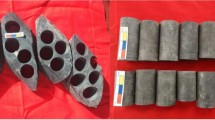Abstract
The catagenesis of organic matter (OM) was modeled by the hydrothermal pyrolysis of a source rock (Riphean mudstone from eastern Siberia). Isothermal experiments 72-h long were carried out in an aqueous environment in autoclaves at temperatures of 300, 310, 320,..., 370°. The pyrolysis products were analyzed for yield of extract, organic carbon, and parameters of Rock-Eval pyrolysis. The amount of the generated liquid hydrocarbon (HC) compounds increased to a temperature of 340°C and then decreased. The experimental trend of the hydrogen index (HI) dependence on the T Max temperature generally coincided with that for natural OM maturation. The carbon isotopic composition of the insoluble (in organic solvents) OM remained practically unchanged in the course of the experiments. The carbon structure of the solid remnants of the experimental samples was ordered (after the experiments) with the origin of turbostratic graphite with a spacing of d 002≈3.5 A°. We also conducted pyrolysis in a diamond anvil cell equipped with a digital camera in order to obtain additional qualitative and quantitative information on oil generation and emigration in the source rock and isolated kerogen. Chemical kinetic parameters of kerogen cracking were calculated for pyrolysis in an open system. The extrapolation of the high-temperature experimental results is discussed with reference to natural OM maturation.
Similar content being viewed by others
References
M. D. Lewan, J. C. Winters, and J. H. McDonald, “Generation of Oil Like Pyrolysis from Organic-Rich Shales,” Science 203, 897–899 (1979).
J. C. Winters, J. A. Williams, and M. D. Lewan, “A Laboratory Study of Petroleum Generation by Hydrous Pyrolysis,” in Advances in Organic Geochemistry 1981, Ed. by M. J. Bjoroy et al., (Wiley, Chichester, 1983), pp. 524–533.
R. L. Braun, A. K. Burnham, J. B. Reynolds, and J. E. Clarcson, “Pyrolysis Kinetics for Lacustrine and Marine Source Rocks by Programmed Miocropyrolysis,” Energy Fuels 5, 193–204 (1991).
W. L. Huang, “A New Pyrolysis Technique Using Diamond Anvil Cell: In-Situ Visualization of Kerogen Transformation,” Org. Geochem. 24, 95–107 (1996).
W. L. Huang and G. A. Otten, “Oil Generation Kinetics Determined by DAC-FS/IR Pyrolysis: Technique Development and Preliminary Results,” Org. Geochem. 29, 1119–1137 (1998).
R. F. Weng, W. L. Huang, C. L. Kuo, and S. Inan, “Characterization of Oil Generation and Expulsion from Coals and Source Rocks Using Diamond Anvil Cell Pyrolysis,” Org. Geochem. 34, 771–787 (2003).
A. E. Kontorovich, V. N. Melenevskii, A. S. Fomichev, and G. Yu. Shvedenkov, “Pyrolysis as a Method for Studying the Oil-Generation Potential of the Source Rocks,” Geol. Nefti Gaza, No. 12, 36–41 (1986).
V. N. Melenevskii, G. Yu. Shvedenkov, A. E. Kontorovich, et al., “Aquapyrolysis of Organic Matter from the Bazhenov Formation,” Dokl. Akad. Nauk 363(5), 678–681 (1998) [Dokl. Earth Sci. 363, 1288–1291 (1998)].
W. A. Bassett, A. H. Shen, M. Bucknum, and I. M. Chou, “A New Diamond Anvil Cell for Hydrothermal Studies to 2.5 GPa and from −190 to 1200°C,” Rev. Sci. Instrum. 64, 2340–2345 (1993).
T. Barth, B. J. Schmidt, and S. B. Nielsen, “Do Kinetic Parameters from Open Pyrolysis Describe Petroleum Generation by Simulated Maturation?,” Bull. Canad. Petrol. Geol. 44, 446–457 (1996).
T. F. Yen, “Structure of Petroleum Asphaltene and Its Significance,” Energy Sources 1, 447–463 (1974).
C. A. Landis, “Graphitization of Disordered Carbonaceous Material in Metamorphic Rocks,” Contrib. Mineral. Petrol. 30, 34–45 (1971).
T. Itaya, “Carbonaceous Material in Pelitic Schists of the Sanbagawa Metamorphic Belt in Central Shikoku, Japan,” Lithos 14, 215–224 (1981).
E. S. Grew, “Carbonaceous Material in Some Metamorphic Rocks of New England and Other Areas,” J. Geol. 82, 50–70 (1974).
B. M. French, “Grafitization of Organic Material in a Progressively Metamorphosed Precambrian Iron Formation,” Science 146, 917–918 (1964).
B. Dahl, J. Bojesen-Koefold, A. Holm, H. Justawan, E. Rassmussen, and E. Thomsen, “A New Interpreting Rock-Eval S2 and TOC Data for Kerogen Quality Assessment,” Org. Geochem. 35, 1461–1477 (2004).
R. W. Jones, “Organic Facies,” in Advances in Petroleum Geochemistry, Ed. by J. Brooks and D. H. Welte (Academic Press, New York, 1987), pp. 1–90.
R. G. Schaeffer, H. J. Schenk, H. Hardelauf, and R. Harms, “Determination of Gross Kinetic Parameters for Petroleum Formation from Jurassic Source Rocks of Different Maturing Levels by Means of Laboratory Experiments,” Org. Geochem. 16, 115–120 (1990).
L. R. Snowdon, “Errors in Extrapolation of Experimental Kinetic Parameters to Organic Geochemical Systems,” AAPG Bull 63, 1128–113 (1979).
V. H. Melenevskii, E. I. Soboleva, and G. Yu. Shvedenkov, “Study of the Relative Thermal Stability of Kerogen and Pyrobitumen (under Experimental Conditions),” Geol. Geofiz., No. 7, 29–35 (1988).
N. H. Bostic, “Phytoclasts As Indicator Thermal Metamorphism, Franciscan Assemblage Great Valley Sequence (Upper Mesozoic), California,” Geol. Soc. Am. Spec. Pap. 153, 1–17 (1974).
G. H. Taylor, M. Teichmuller, A. Davis, et al., Organic Petrology (Berlin, Stuttgart, 1998).
Author information
Authors and Affiliations
Corresponding author
Additional information
Original Russian Text © V.N. Melenevsky, A.E. Kontorovich, Wuu-Liang Huang, A.I. Larichev, T.A. Bul’bak, 2009, published in Geokhimiya, 2009, No. 5, pp. 504–512.
Rights and permissions
About this article
Cite this article
Melenevsky, V.N., Kontorovich, A.E., Huang, WL. et al. Hydrothermal pyrolysis of organic matter in Riphean mudstone. Geochem. Int. 47, 476–484 (2009). https://doi.org/10.1134/S0016702909050048
Received:
Published:
Issue Date:
DOI: https://doi.org/10.1134/S0016702909050048




